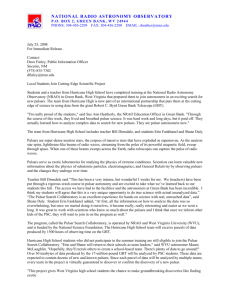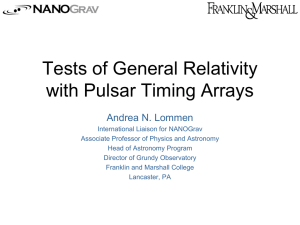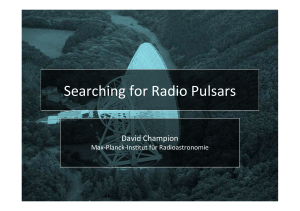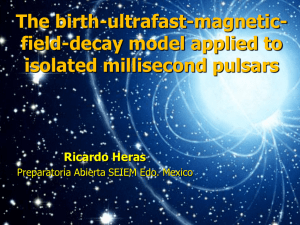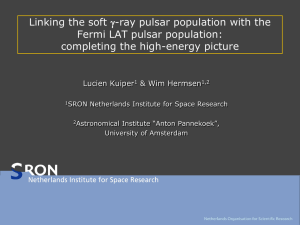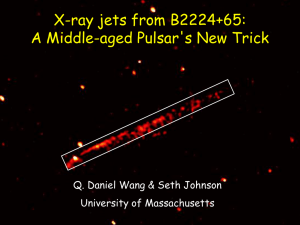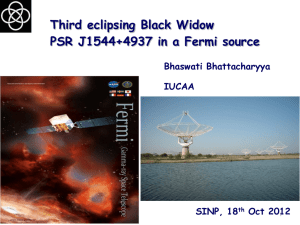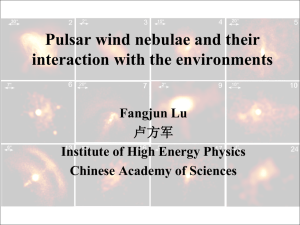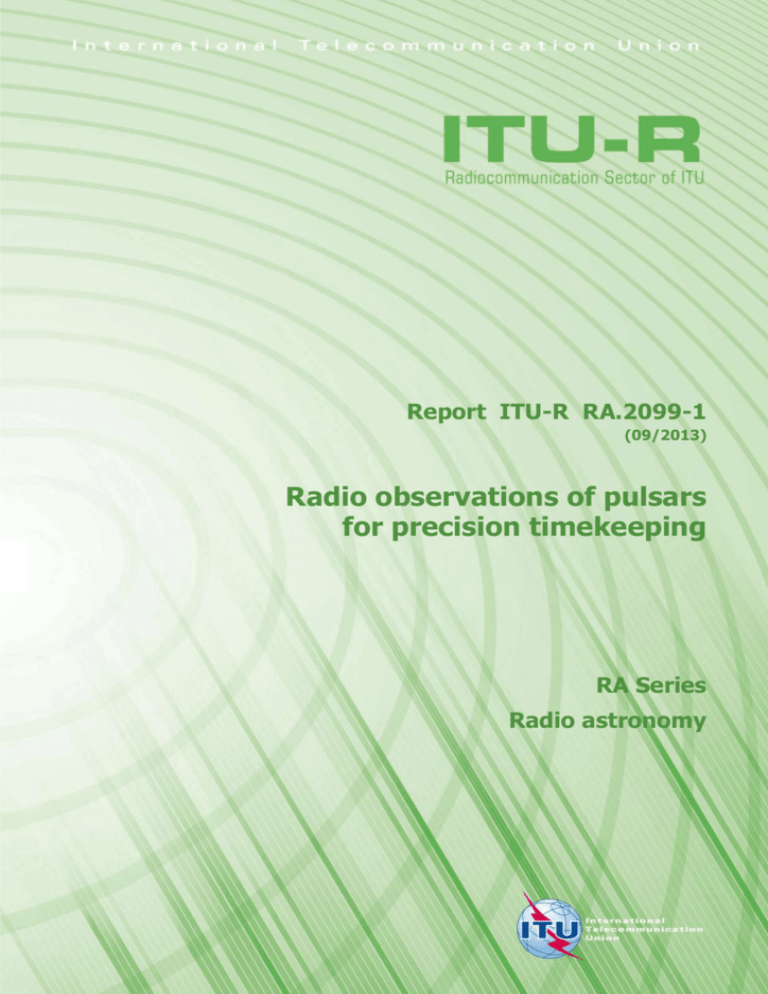
Report ITU-R RA.2099-1
(09/2013)
Radio observations of pulsars
for precision timekeeping
RA Series
Radio astronomy
ii
Rep. ITU-R RA.2099-1
Foreword
The role of the Radiocommunication Sector is to ensure the rational, equitable, efficient and economical use of the
radio-frequency spectrum by all radiocommunication services, including satellite services, and carry out studies without
limit of frequency range on the basis of which Recommendations are adopted.
The regulatory and policy functions of the Radiocommunication Sector are performed by World and Regional
Radiocommunication Conferences and Radiocommunication Assemblies supported by Study Groups.
Policy on Intellectual Property Right (IPR)
ITU-R policy on IPR is described in the Common Patent Policy for ITU-T/ITU-R/ISO/IEC referenced in Annex 1 of
Resolution ITU-R 1. Forms to be used for the submission of patent statements and licensing declarations by patent
holders are available from http://www.itu.int/ITU-R/go/patents/en where the Guidelines for Implementation of the
Common Patent Policy for ITU-T/ITU-R/ISO/IEC and the ITU-R patent information database can also be found.
Series of ITU-R Reports
(Also available online at http://www.itu.int/publ/R-REP/en)
Series
BO
BR
BS
BT
F
M
P
RA
RS
S
SA
SF
SM
Title
Satellite delivery
Recording for production, archival and play-out; film for television
Broadcasting service (sound)
Broadcasting service (television)
Fixed service
Mobile, radiodetermination, amateur and related satellite services
Radiowave propagation
Radio astronomy
Remote sensing systems
Fixed-satellite service
Space applications and meteorology
Frequency sharing and coordination between fixed-satellite and fixed service systems
Spectrum management
Note: This ITU-R Report was approved in English by the Study Group under the procedure detailed in
Resolution ITU-R 1.
Electronic Publication
Geneva, 2013
ITU 2013
All rights reserved. No part of this publication may be reproduced, by any means whatsoever, without written permission of ITU.
Rep. ITU-R RA.2099-1
1
REPORT ITU-R RA.2099-1
Radio observations of pulsars for precision timekeeping
(Question ITU-R 205/7)
(2007-2013)
Scope
This Report examines the possibility of using high-precision timing radio observations of millisecond
pulsars for constructing and maintaining new pulsar-based astronomical time-scales. No changes in the
Radio Regulations (RR) are needed to enable this activity.
1
Introduction
Pulsars are identified with strongly magnetized, rapidly-rotating neutron stars. The presently known
pulsars have masses of order 1.5 times the solar mass, diameters of about 20 km and spin rotation
periods from 1.39 ms up to 11.7 s. Clearly pulsars have large moments of inertia and large stores of
rotational energy, and so can be treated as space “flywheels” with stable rotation periods that can be
used for precision astronomical timekeeping [Manchester and Taylor 1977]. In 1993, ITU
recognized the potential use of pulsars for precision timekeeping, and adopted
Question ITU-R 205/7, as well as Opinion ITU-R 99 “Time-scale based on pulsar timing” (2003).
Pulsars, as sources of regular radio pulses, have “life times” of a few millions to billions of years.
There are two well-known groups of pulsars. The first of these are normally isolated objects, which
usually have periods of 0.2 s to 8 s. The second class are very rapidly rotating pulsars, which are
often in binary stellar systems, the so-called “millisecond” pulsars, with periods of 1.39 ms to
50 ms. At this time more than two hundreds such pulsars are known. Millisecond pulsars are
believed to originate when mass is accreted from a companion onto a neutron star. They are thus
recycled old pulsars that have magnetic fields of about 104 T (108 G).
Pulsars in close binary systems have orbital periods that range from a few hours up to several
months. Their orbital parameters can be determined by high-precision timing observations.
Some millisecond pulsars have spin-period instabilities as small as 0.12 µs over five years, i.e. a
relative frequency instability of 5 * 10–16. Their radiation losses are negligible, so that the rotation
period of some systems increases with as little as 10–21 s/s (i.e. seconds per second), and usually
linearly with time (ITU-R Handbook – Radio Astronomy, edition 2013). Better accuracy can be
achieved by using of ensemble time-scale based on the observations of an ensemble of pulsars. At
long-time intervals (a few years), this time-scale has a stability which is comparable with the
stability of atomic time-scales (Joint Discussion JD6 “Time and Astronomy”, XXVII IAU GA,
Rio de Janeiro, August 2009).
Thus, pulsars are well suited to the role of providing mankind with highly regular space clocks,
which permits the generation of new, pulsar-based, astronomical time-scales, both a Pulsar
Time-scale (PT) and a Dynamic Pulsar Time-scale (DPT) – [Ilyasov et al., 1998, Il'in et al., 1984,
Ilyasov, 2006, Manchester, 2011, Stappers et al., 2006, Souchay, 2006].
The extreme rotational stability of pulsars allows the application of a unique technique to increase
the S/N ratio of pulsar profiles – the “synchronous integration mode”, in which the signal is
summed synchronously with the pulsar period.
Precision pulsar timing programmes are being conducted at radio observatories in Australia, France,
Germany, Japan, the Netherlands, the Russian Federation, the United Kingdom and the United
2
Rep. ITU-R RA.2099-1
States of America (USA). Ensembles of millisecond pulsars (or Pulsar Timing Array – PTA) are
observed regularly for forming of pulsar time-scale in these programmes.
2
Preferred frequency bands for high-precision timekeeping observations of radio
pulsars
Observations of pulsars are currently made in a wide range of frequencies, from 10 MHz up to
40 GHz. The basic achievable noise level in radio astronomical observations is defined primarily in
the metre wavelength range by Galactic background radiations, though at higher frequencies, the
receiver noise dominates the total noise. The brightness temperature of the Galactic background
decreases from several thousand kelvins (K) at frequencies around 100 MHz down to 1-10 K at
1 GHz, and is characterized by a flux-density:
S ( f ) f
where f is radio frequency, and the spectral index is about 2.5.
On the other hand, the flux-density of pulsars decreases with frequency, following a spectral index
of about 2 (on average). A low noise preamplifier in a pulsar receiver typically has a noise
temperature of 10 K for receivers in the frequency range 1-10 GHz. The best S/N is achieved by
observing in the 0.4-2.0 GHz range [Ilyasov et al, 1999].
The S/N ratio increases with receiver bandwidth: the gain in observing sensitivity for a bandwidth
f is proportional to f . It is well known that pulsar’s pulses are dispersed as they propagate
through the interstellar medium, such that the magnitude of the resulting delay in the pulse arrival
time decreases as the square of the frequency. From this point of view, higher frequencies are
preferable. The magnitude of the resulting delay depends on the electron density along the line of
sight to the pulsar, and is characterized by the “dispersion measure” (DM). The effects of dispersion
can be removed from the signal using techniques based on multichannel filter-bank receivers in the
time domain or coherent de-dispersion in the frequency domain.
Multipath scattering in the interstellar medium causes a broadening of pulses of radio emission from
pulsars, which decreases approximately as f 4. This is also an argument for using higher frequencies
in pulsar timing, when possible.
Therefore, the dispersion measure is usually not entirely stable, so precise pulsar timing at about the
microsecond level requires observations, preferably simultaneously, in at least two frequency bands
that are separated by an octave, to measure the changes in dispersion measure.
The preferred frequency bands for high-precision timing observations of pulsars for precision
timekeeping are the 1 400-1 427, 2 690-2 700, 4 990-5 000 MHz radio astronomy service (RAS)
bands, in conjunction with either the 608-614 MHz band or the 406.1-410 MHz radio astronomy
band for monitoring variations of dispersion measure.
3
Threshold levels of interference
Pulsars are generally weak radio sources. Clearly, it is necessary to achieve a significant S/N to get
a precise measurement of the time of arrival (TOA) of the pulse of a pulsar. High-precision pulsar
timekeeping observations therefore need to be protected from harmful interference. The threshold
levels for interference detrimental to high-precision pulsar timing are those given in Table 2 of
Recommendation ITU-R RA.769 for single-dish continuum observations.
Rep. ITU-R RA.2099-1
4
3
The feasibility of frequency sharing with other services
High-precision timing observations of pulsars intended for maintaining a pulsar-based time-scale
can usually be conducted using the frequency bands allocated to the RAS. Radio astronomy does
not share the 1 400-1 427, 2 690-2 700 or 4 990-5 000 MHz bands with any active service. In the
406.1-410 MHz band sharing is possible with the fixed and mobile except aeronautical mobile
services and in the 608-614 MHz band sharing is possible with the terrestrial broadcasting service
(Region 1), the mobile-satellite except aeronautical-mobile satellite (Region 2) and the fixed,
mobile, radionavigation and broadcasting services (Region 3) as RAS stations are located at remote
sites, and mobile-satellite service links are Earth-to-space.
5
The most appropriate pulsars for use in high-precision timekeeping
For the purpose of high-precision timekeeping, the most appropriate pulsars are those which have
the highest radio power flux-densities and the most stable periods, and which are observable from
both the northern and southern hemispheres. New pulsars are constantly being discovered, and
some of these are in systems that can be used to advantage for precision timekeeping: ongoing
pulsar surveys make any list of preferred pulsars dynamic. Currently, the ensemble of pulsars that
fulfils these constraints is listed in Table 1.
TABLE 1
The list of pulsars included in different programmes
Pulsar
(J2000)
1
Australia
(PPTA)
2
Europe
(EPTA)
3
Russian
Federation
(KPTA)
4
0030+0451
σresidual TOA (µs)
6
+
0034-0534
+
0218+4232
+
0437-4715
+
0613-0200
+
0621+1002
0711-6830
USA
(NANOGrav)
5
0.12
+
+
0.83
+
+
1012+5307
1.56
+
+
+
+
+
1022+1001
+
1024-0719
+
1.2
1045-4509
+
1.44
1455-3330
1600-3053
1.11
+
+
+
+
0.35
4
Rep. ITU-R RA.2099-1
TABLE 1 (end)
Pulsar
(J2000)
1
Australia
(PPTA)
2
1603-7202
+
1640+2224
Europe
(EPTA)
3
Russian
Federation
(KPTA)
4
USA
(NANOGrav)
5
σresidual TOA (µs)
6
1.34
+
+
+
+
+
2.1
+
+
0.19
1643-1224
+
1713+0747
+
1730-2304
+
1.82
1732-5049
+
2.4
1744-1134
+
+
1824-2452
+
+
+
+
0.65
0.88
1853+1308
+
1857+0943
+
+
+
2.09
1909-3744
+
+
+
0.22
1910+1256
+
1918-0642
+
1939+2134
+
+
+
1955+2908
0.17
+
2124-3358
+
2
2129-5721
+
0.91
2145-0750
+
2317+1439
+
+
+
1.44
+
Notes to Table 1:
Column 1
Pulsar name (J2000 convention).
Columns 2-5 Observations of the pulsars in Australia, Europe, the Russian Federation, USA
respectively (PPTA – Parkes PTA, EPTA – Europe PTA, KPTA – Kalyasin PTA,
NANOGrav – the North American Nanohertz Observatory for Gravitational Waves).
Column 6
rms of residuals of TOA (time of arrival). This is one of the parameters that indicate the
expected accuracy of the pulsar’s time-scale after one year’s observation.
Rep. ITU-R RA.2099-1
6
5
Conclusions
This Report answers Question ITU-R 205/7, which was formulated for exploring the use of
high-precision timing observations of millisecond pulsars for constructing and maintaining new
pulsar-based astronomical time-scales PT and DPT.
–
The preferred frequency bands for high-precision timing observations of radio pulsars for
the purpose of precision timekeeping are the RAS bands 1 400-1 427, 2 690-2 700,
4 990-5 000 MHz, and either 406.1-410 MHz or 608-614 MHz bands.
–
The threshold levels for interference detrimental to high-precision pulsar timing are those
given in Table 2 of Recommendation ITU-R RA.769 for single-dish continuum
observations.
–
The aforementioned, preferred, RAS bands do not require any change in frequency
allocations or in sharing arrangements with any of the active services sharing the bands
with the RAS.
–
The final goal of providing a new, long-term, stable time-scale by using the most
appropriate pulsars (see Table 1) as reference clocks is making precision timing
observations. New pulsars are constantly being discovered, and can be used to advantage
for precision timekeeping. Therefore, the list of pulsars used for timekeeping will increase
in the future.
References
ILYASOV, KOPEIKIN and RODIN [1998] Astronomy Letters, Vol. 24, p. 275.
ILYASOV, KUZMIN, SHABANOVA and SHYTOV [1999] Pulsar time-scale, Lebedev Proc., Vol. 199.
MANCHESTER and TAYLOR [1977] Pulsars, Freeman, San Francisco, CA.
ITU Handbook on Radio Astronomy, 2nd edition, 2003.
MANCHESTER, R. N., HOBBS, G. B., TEOH, A., HOBBS, M. “ATNF Pulsar Catalog”, “Astronomical
Journal”, 2005, Vol. 129, p. 1993-2006 (www.atnf.csiro.au/reseach/pulsar/psrcat).
IL‘IN, V. G., ILYASOV, Yu. P., KUZMIN, A. D. et al (7 co-authors) [1984] Pulsar time scale, The USSR
Academy Reports Vol. 274, No. 4, p. 275-284.
ILYASOV, YU. P. [2006] Millisecond Pulsar Timing at Kalyazin Observatory, Chinese Journal of
Astronomy and Astrophysics, Vol. 6, Suppl. 2, p. 148-156.
MANCHESTER, R. N. [2011] The Pulsar Timing Arrays and their applications, arXiv: 1101.5202
[astro-ph].
STAPPERS, B. W., KRAMER, M., LYNE, A. G., D'AMICO, N., JESSNER, A. [2006] “The European
Pulsar Timing Array”, Chinese J. Astron and Astroph. Vol. 6, p. 298-303.
SOUCHAY, J., COGNAR, I. [2006] “Pulsars: timing reduction at Nançay’s radio telescope and construction
of an astrometric catalog”, IERS Technical Note, No. 34, p. 29-34.

